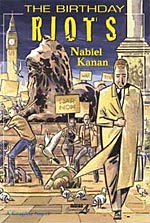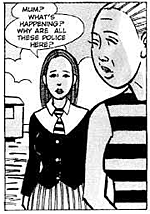>> The Friday Review: The Birthday Riots
>> The Friday Review: A Distant Soil: The Gathering
More...

 Writer/Artist: Nabiel Kanan
Writer/Artist: Nabiel Kanan
Price: $ 14.95
Publisher: NBM
ISBN: 1-56163-299-6
Recently, the Labour government in England marked its fifth year in power. Back in 1997, I was a second year student who, having lived through almost twenty years of Conservative rule, was overjoyed to see them on the way out.
One of my fondest memories of university is spending the early hours of the morning watching the results come in with my friend Andy, a huge avuncular Welshman whose bellowed laughter and "Take that you bastards!" cries of victory woke the whole house. We laughed like maniacs at about 2am, and kept going the next day. They were gone, and things would be better now.
Five years down the line, we're all a little older and wiser. Labour may not be the Conservatives, but recent events have suggested that they're pretty close to them in mindset. The failure to discipline spin doctor Jo Moore for her comments regarding the attacks on the World Trade Center, the meltdown suffered by the country's railways and, most of all, the perception of a government that avoids blame at all costs have all led to a growing sense of political apathy.
We're living in a political fog, with most of the populace not caring what decisions are made, and the three main political parties closer than ever in perception and world view. There are no clear differences, no quick fixes, and everyone wears the same suit.
This is the world of THE BIRTHDAY RIOTS.
More specifically, it's the world of Max Collins. In Collins, Nabiel Kanan not only sets out his stall for how the story will unfold, but also creates a protagonist genuinely unique in the comic industry. Collins has more in keeping with the main characters of Ian McEwan and Martin Amis than their nearest comic equivalents. He's a middle-to-upper class, highly successful political analyst with a good house, a happy marriage and a good family.
But he's also under tremendous pressure. With the London mayoral elections looming, Max feels he's faced with difficult choices in every aspect of his life. More importantly, and in a tremendous act of narrative courage on Kanan's part, Max fails almost every single one of them.
 This is best demonstrated by the scenes between Max and his family. The opening of the novel portrays the Collins family as cheerfully diverse in the best tradition of the middle classes. Max is a political analyst, his wife is an artist, and their two children articulate, clean and healthy. They're a perfect snapshot of middle England, as ignorant as they are happy.
This is best demonstrated by the scenes between Max and his family. The opening of the novel portrays the Collins family as cheerfully diverse in the best tradition of the middle classes. Max is a political analyst, his wife is an artist, and their two children articulate, clean and healthy. They're a perfect snapshot of middle England, as ignorant as they are happy.
These early scenes show Kanan doing what he does best, writing about real people. The exchanges between the Collinses have a rhythm all their own, filled with familial in-jokes and turns of phrase that are both natural and tremendously realistic. In a medium saturated by speech making and bombast, it's a credit to Kanan's writing that these seemingly mundane exchanges work so well.
Indeed, the overwhelming impression the reader takes away from these opening scenes is that the Collinses are a loving, strong family who actually care about one another. Poignant without ever being forced, and funny without ever resorting to pratfalls, these scenes remain some of the strongest in the book.
However, as RIOTS progresses it becomes clear what Kanan's aim is. With his main character being paid to alter people's perceptions, Kanan uses the same techniques to continually throw the readers off, forcing them to re-evaluate characters almost from page to page. As the story progresses, for example, it becomes clear that Max's wife is far less liberal than she first appears, while his son is easily led into the early stages of racism. Neither character becomes unsympathetic or unpleasant, but rather, they change in the reader's eyes. Instead of a friendly little boy we see a young man who laughs at gypsy jokes. It's the same character, but seen from a different perspective.
This constant reassessment of character is best embodied by Max Collins. As RIOTS progresses, Kanan takes Max through almost the entire range of human emotion and perception. He moves from loving husband and father to political operator, lothario and class traitor all without ever seeming to change his behaviour. Instead, Kanan simply provides us with more information, forcing the reader to continually reassess Max's actions. It's never clear until the final scenes whether Max is doing what he's doing because of his basic decency or his guilt at the times that decency has failed him, for example.
 This kind of moral complexity is commonplace in Kanan's work, but not nearly commonplace enough in the market as a whole. Here, it works superbly well, creating a character in Max who we respect, loathe and pity in roughly equal proportions, and never feel entirely comfortable with. Even at the conclusion of RIOTS, he remains a fascinating, complex and utterly distinct character. A man trapped between doing what's right and what's expected of him.
This kind of moral complexity is commonplace in Kanan's work, but not nearly commonplace enough in the market as a whole. Here, it works superbly well, creating a character in Max who we respect, loathe and pity in roughly equal proportions, and never feel entirely comfortable with. Even at the conclusion of RIOTS, he remains a fascinating, complex and utterly distinct character. A man trapped between doing what's right and what's expected of him.
This conflict of interest is echoed throughout the story. Max is a man torn between his job and his family, his house and family in the country and his business and potential mistress in the city. It's even present in the story itself, with Max's daughter becoming drawn into the struggle of the gypsy community against legislation that will outlaw them, even as Max comes down in favour of those laws. Both are tainted by politics, both are compromised by what they're forced to do, and yet both are right. Here, there are no easy answers and there is no true right or wrong: only differences of perception.
It's ironic, then, that for a book so concerned with the grey areas, its structure should be so rigid. The book uses a nine-panel grid structure throughout, but from time to time, some of the panels are replaced by a single, larger image.
In this way, Kanan uses the structure of the book to dictate it's pacing. These larger illustrations are either moments of dramatic tension or are used to make a point within the boundaries of the story. One is featured in the confrontation between Max and Helen, while another, this time a full page splash image, is used to close the first chapter of the book.
This approach establishes a rhythm not only in the story, but in how the story is read. The first chapter's splash page, for example, draws the reader's attention to two components of the overall image. Firstly, the sprawling gypsy encampment, and secondly, Max looking out at it from his window, a very small man in a very large picture. It's a visual shorthand that provides a rhythm for both the story and the reader's pace.
It also forces the reader to focus on the main characters, as most of the time panels contain little more than one or two of them in closeup, continually bringing the reader and character as close together as possible. And it also gives Kanan a framework for each page, and one that allows him tremendous economy and freedom of art. For example, the flashback sequences are presented in panels with curved edges. By creating this 'television' feel, Kanan gives the sequences a unique tone without ever alienating the reader.
It would be easy to write THE BIRTHDAY RIOTS off as little more than a simple tragedy. After all, superficially it's a story about the failings of a man who only knows how to succeed. However, it's far more than that. This is a story about redemption, and what people are prepared to do to get it, and it's a frequently funny and extremely compassionate read.
Ultimately, THE BIRTHDAY RIOTS is the unflinching portrayal of a man who isn't perfect, and what he does when he finally realises that. While elements are tragic, the story as a whole is a great deal more than that. One part political diatribe and one part character study, its literature with a capital 'L', and quite unlike anything else on the market. That alone should be recommendation enough.

This article is Ideological Freeware. The author grants permission for its reproduction and redistribution by private individuals on condition that the author and source of the article are clearly shown, no charge is made, and the whole article is reproduced intact, including this notice.


